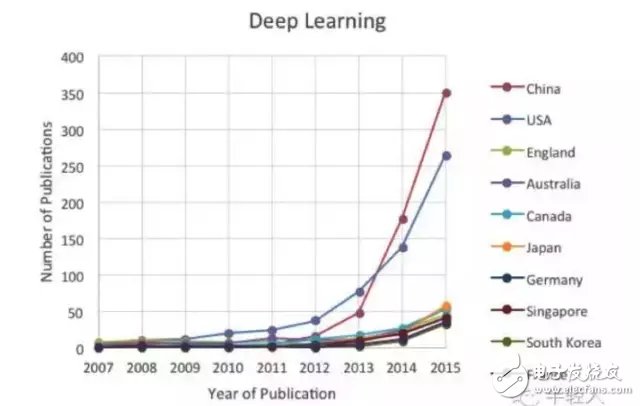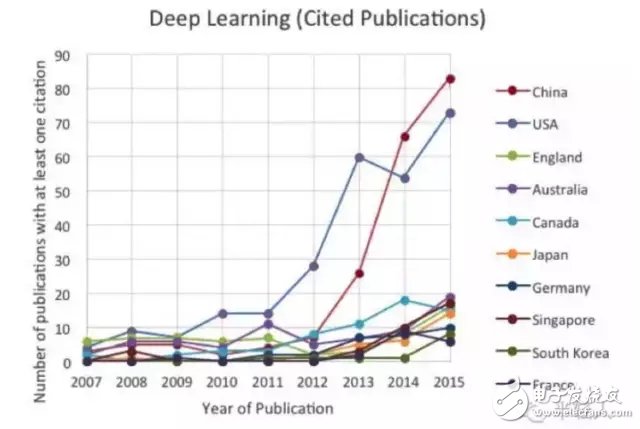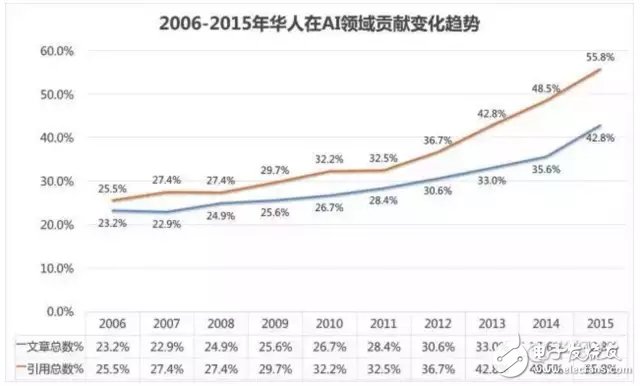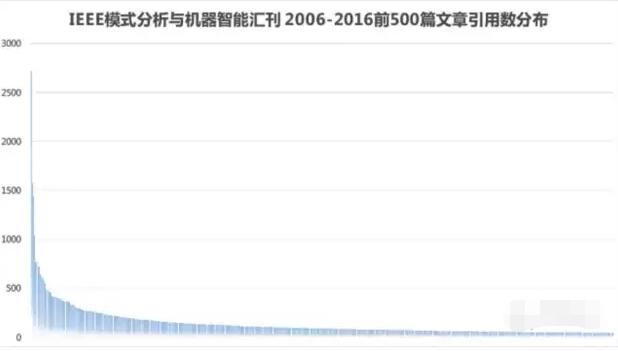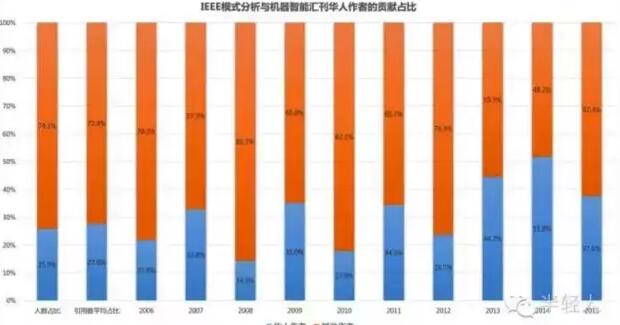The fire of artificial intelligence has already burned to the national strategic level, and even the US president and government agencies have also rolled in. Obama presided over the White House frontier summit and looked forward to the development of the United States in the next 50 years. In the summit, the White House released the report “National Artificial Intelligence Research and Development Strategy Planâ€. For related information, you can refer to the Wired: Barack Obama on ArTIficial Intelligence (Autonomous Cars, and the Future of Humanity). In the past two days, the report has not been hyped up by the media; I myself is particularly interested in the two trend graphs in this report. According to the report, from 2013 to 2015, in the papers included in SCI, the article about “deep learning†increased about six times, and stressed that “by the number of articles, the United States is no longer the first in the world. †The United States is not the world's first Who is the number one in the world? The above picture shows the trend of the number of articles in “Deep Learning†or “Deep Neural Network†in the articles included in the annual SCI, and distinguishes them by country. The data itself is queried from the core database of Web of Science. The second picture, like the other conditions in the first picture, adds an additional condition that "the article must be quoted at least once." In other words, the number of articles counted in the second chart is the number of "effective articles" that have been cited, which is relatively more reasonable. In both figures, China surpassed the United States (and all other second-tier countries) in 2014 and 2015, and was the leader. From the intuition of these years, the Chinese/Chinese people are everywhere in the field of artificial intelligence. Wu Enda, Sun Jian, Yang Qiang, Huang Guangbin, Ma Yi, Zhang Dapeng... You can say a bunch of words, I am at Google. The research team, Microsoft Research Institute and other places have seen it with the eyes of Chinese and Chinese. But this is just an intuitive feeling. On the whole, how important is the contribution of Chinese/Chinese research, and how much is the promotion of artificial intelligence? Is the statistics in the White House report scientific and reasonable? 1. Direct search for the keywords “deep learning†and “deep neural network†can really cover all scientific research progress in the field of artificial intelligence in these years? In the fields of robotics, intelligent control, machine vision, and driverless driving, there are still many articles that do not mention deep learning. How many related articles will be missed by strict keyword matching? Does it affect the statistical results? 2, "The article is quoted at least once", it is more scientific, but it seems that it is not enough. Does this kind of statistics really need to consider the impact factor of SCI? If you don't think about it, how many comparative papers published in poor journals will be mixed? Will these data be polluted by domestic research institutions based on the number of SCI citations? 3. In the era of globalization, according to national statistics, will there be obvious deviations? The White House report did not mention how the articles being counted were classified in different countries. If the institution where the author published the article, will a large number of Chinese scholars visiting foreign institutions be counted as foreigners? How do statistics on articles written by Chinese and foreigners? If the journals are in the same country and region, will the differences in journal levels (impact factors) between different countries bias the statistical results? Based on this, I also want to do statistics myself. 1. Starting from the impact factor of the journal, only the top journals with high impact factors are counted. 2. Starting from the WebofScience keyword, covering all areas of research related to artificial intelligence, not just articles on deep learning. 3. The target of attention is Chinese, rather than using national classification to compare China and foreign countries – this is my own choice, because today's academic circles, cooperation and exchanges between countries can not be ignored. Foreign Chinese like Wu Enda are actually contributing to the development of artificial intelligence in China. Instead of defining a country, it is better to look at it as a whole. How many Chinese scientists and researchers are on the planet. 4. The time frame of attention is from 2006 to 2016, spanning about 10 years – because many people say that this wave of artificial intelligence has only really begun to emerge in the years after 2006. My statistics Let me talk about my statistical results. I will talk about the statistical methods I use in Appendix I later. Look at the average contribution of Chinese authors between 2006 and 2016: In the period from 2006 to 2016, among the top 20,000 artificial intelligence articles, the number of articles contributed by the Chinese and the number of citations accounted for 29.2% and 31.8% of the total, respectively. In the past ten years, the Chinese have contributed an average of 30% of the top AI research articles and cited numbers by about one-fifth of the authors. From a statistical point of view, this is already a research contribution beyond the average level. But the average does not show the extent of Chinese scientists and researchers in recent years. Looking at the trend of the number of articles contributed by the Chinese and the number of citations between 2006 and 2015: Between 2006 and 2015, the proportion of top AI papers by Chinese authors, which accounted for the total number of top AI papers, increased from 23.2% to 42.8%. The number of citations of the top AI papers that Chinese authors participated in, the proportion of citations of all top AI papers increased from 25.5% to 55.8% (in 2016, there was less data and was not used for trend comparison). That is to say, even if only the top articles in the top publications are counted, the contribution of Chinese/Chinese in the field of artificial intelligence is similar to the law revealed in the White House report – no matter from which angle, the Chinese / Chinese are playing a pivotal role in the field of artificial intelligence. Moreover, starting from 2014 and 2015, Chinese/Chinese are already in the leading position in artificial intelligence research, occupying half of the artificial intelligence research world! Does anyone think this statistic is incredible? Will this result be unexpected? We can also take a more specific example to analyze it in depth. In the top AI journals and conference proceedings, let me give you a famous example: IEEE TransacTIons on Pattern Analysis and Machine Intelligence (PAMI), the impact factor of 6.077 in 2015, high to no Friends, students who want to submit articles here may know how terrible it is to be accepted and published. I selected the top 500 papers from 2006 to 2016 by reference to IEEE Pattern Analysis and Machine Intelligence. The following is the distribution of the citations of these 500 papers: In fact, it is very scary. The top 500 articles have a maximum number of references of 2715 and the lowest number of quotes is 41 - the top journals! Ordinary journals are hard to find their backs. So, what are the contributions of Chinese scientists and researchers in these 500 top-level artificial intelligence papers? Let me talk about a few numbers: the total number of authors of 500 top articles is 1,220, including 316 Chinese scientists and researchers, accounting for 25.9%. The total number of citations counted by all authors was 231,361, of which the total number of citations by Chinese scientists and researchers was 63,846, accounting for 27.6%. If we look at the data in 2014 (the number of Chinese articles and the number of citations are high), the number of Chinese scientists and researchers cited is 51.8%, more than half. If you only look at the IEEE Model Analysis and Machine Intelligence Journal from 2006 to 2016, the specific situation of the 10 Chinese authors and 10 non-Chinese authors with the most citations is also an interesting form: The top 10 Chinese bulls in the IEEE Model Analysis and Machine Intelligence Journal, and the top 10 bulls in non-Chinese, are almost equal in total number of citations per person. Indeed, among the top artificial intelligence scientists, the Chinese/Chinese contribution is no less than other scientists. Also, if you are unfamiliar with the field of artificial intelligence, especially pattern recognition, remember the names of the top 20 scientists in the table. If you are interested, you can search for their resumes, see where they work, where to do research, who their students and colleagues are, I believe there will be many discoveries. Why are Chinese/Chinese so strong in the field of artificial intelligence? Because math is good? Because of interest? Because of the habit of thinking? Because of diligence? Because of education? Everyone may have their own answer. This article does not want to discuss, enumerate data and facts, is the purpose of this article. Briefly explain how I got the ratio and trend data above. On the weekends, I went to the Web of Science database to find the subject categories of Computer Science/ArTIficial Intelligence, sorted from top to bottom according to the 2015 SCI impact factor, and took the top 50 publications (including journals and conference proceedings). A detailed list of top journals and conference proceedings in the field of personal intelligence is given in Appendix II. Then, for each top journal and conference proceedings, sort all articles from 2006 to 2016 based on the number of citations of the article. In this period, the average number of articles published in journals and conference proceedings is around 500. I use 500 as the upper limit, and the number of articles with the most citations in each journal and conference proceedings is up to 500. This resulted in a total of 19,85 articles related to top intelligence from 2006 to 2016. Next, based on the author list and the number of citations of these articles, the relationship between the proportions and trends of Chinese scientists, researchers and authors of all articles is counted. How to identify Chinese authors? There seems to be no particularly good way. My method is based on the English name. If the English name is mainly composed of Hanyu Pinyin, Wei's Pinyin or Cantonese Pinyin (of course, we must also consider the difference between the surname and the name in English, and other rules of thumb), then Assume that this author is Chinese. According to the small sample set verification, the detection rate of this method is about 96%, and the detection rate is about 90%. In other words, there will be a certain number of omissions, and there will be a small amount of misunderstanding, but it can basically reflect the overall situation and trends. How to solve the problem of collaborators? I am counting separately and not weighted. The first author and other authors share article counts and reference counts. Does adding weight to the first author affect the overall statistical results? Perhaps, but it will not affect the overall trend data, because there is no evidence that the Chinese are more of the first author, or non-Chinese are more of the first author. As for the number of articles and citation counts of each author, whether to use simple accumulation or proportional accumulation (such as two people cooperation, each person's contribution is 0.5 or 1), I did a full data set comparison test, almost no impact Overall result. Top 50 AI journals and conference proceedings listed by impact factor: IEEE TRANSACTIONS ON FUZZY SYSTEMS, 6.701 International Journal of Neural Systems, 6.085 IEEE TRANSACTIONS ON PATTERN ANALYSIS AND MACHINE INTELLIGENCE,6.077 IEEE TRANSACTIONS ON EVOLUTION ARYCOMPUTATION, 5.908 INTEGRATED COMPUTER-AIDEDENGINEERING, 4.981 IEEE Transactions on Cybernetics, 4.943 IEEE Transactions on Neural Networks and Learning Systems, 4.854 MEDICALIMAGE ANALYSIS, 4.565 Information Fusion, 4.353 INTERNATIONAL JOURNAL OF COMPUTER VISION, 4.27 IEEE TRANSACTIONS ON IMAGEPROCESSING, 3.735 IEEE Computational Intelligence Magazine, 3.647 EVOLUTION ARYCOMPUTATION, 3.6 IEEE INTELLIGENT SYSTEMS, 3.532 PATTERN RECOGNITION, 3.399 ARTIFICIAL IN TELLIGENCE, 3.333 KNOW LED GE-BASED SYSTEMS, 3.325 NEURAL NETWORKS, 3.216 EXPERTSYSTEMSWITHAPPLICATIONS, 2.981 Swarm and Evolutionary Computation, 2.963 APPL IED SOFT COMPUTING, 2.857 DATA MINING AND KNOW LEDGE DISCOVERY, 2.714 INTERNATIONAL JOURNAL OF APPROXIMATEREASONING, 2.696 SIAM Journalon Imaging Sciences, 2.687 DECISION SUPPORT SYSTEMS, 2.604 Swarm Intelligence, 2.577 Fuzzy Optimization and Decision Making, 2.569 IEEE TRANSACTIONS ON KNOW LEDGE AND DATA ENGINEERING, 2.476 JOURNA LOF MACHINE LEARNING RESEARCH, 2.45 ACM Transactions on Intelligent Systems and Technology, 2.414 NEUROCOMPUTING, 2.392 ENGINEERINGAPPLICATIONSOFARTIFICIALINTELLIGENCE, 2.368 CHEMOMETRICSANDINTELLIGENTLABORATORYSYSTEMS, 2.217 ARTIFICIALINTELLIGENCEINMEDICINE, 2.142 COMPUTERVISIONANDIMAGEUNDERSTANDING, 2.134 JOURNAL OF AUTO MATEDREASONING, 2.113 INTERNATIONAL JOURNAL OFI NTELLIGENT SYSTEMS,2.05 COMPUTATION ALLINGUISTICS, 2.017 ADVANCE DENGINEERING INFORMATICS, 2 JOURNAL OF INTELLIGENT MANUFACTURING, 1.995 Cognitive Computation, 1.933 IEEE Transactions o n Affective Computing, 1.873 JOURNALOFCHEMOMETRICS, 1.873 MECHATRONICS, 1.871 IEEE Transactions on Human-Machine Systems, 1.8 Semantic Web, 1.786 IMAGE AND VISION COMPUTING, 1.766 Wiley Interdisciplinary Reviews-Data Mining and Knowledge Discovery, 1.759 NEURAL PROCESSING LETTERS, 1.747 ARTIFICIAL INTELLIGENCERE VIEW, 1.731 Delicate IC Lead Frame,Lead Frame High Precision,0.25mm Thickness IC Lead Frame SHAOXING HUALI ELECTRONICS CO., LTD. , https://www.cnsxhuali.com
